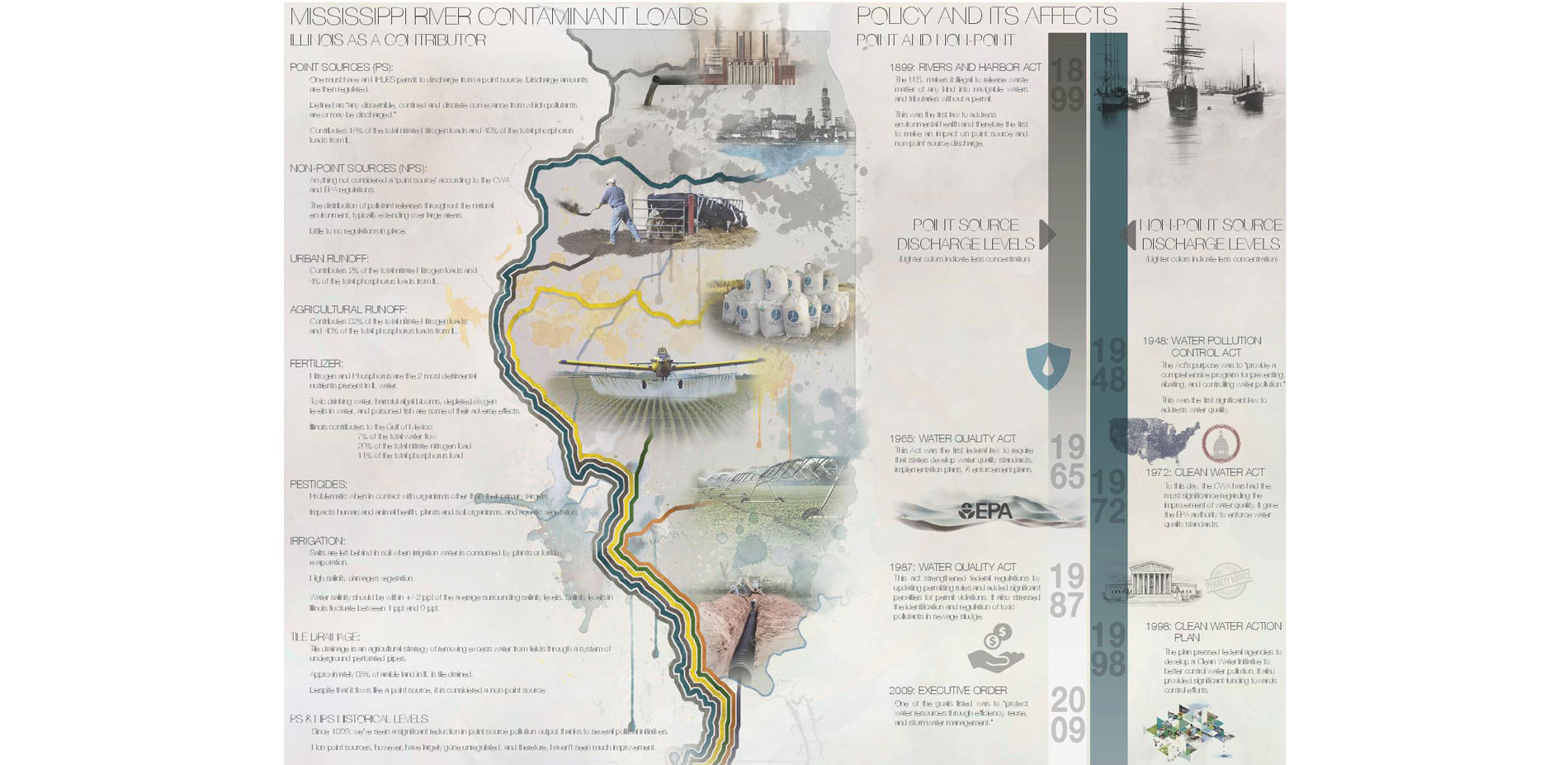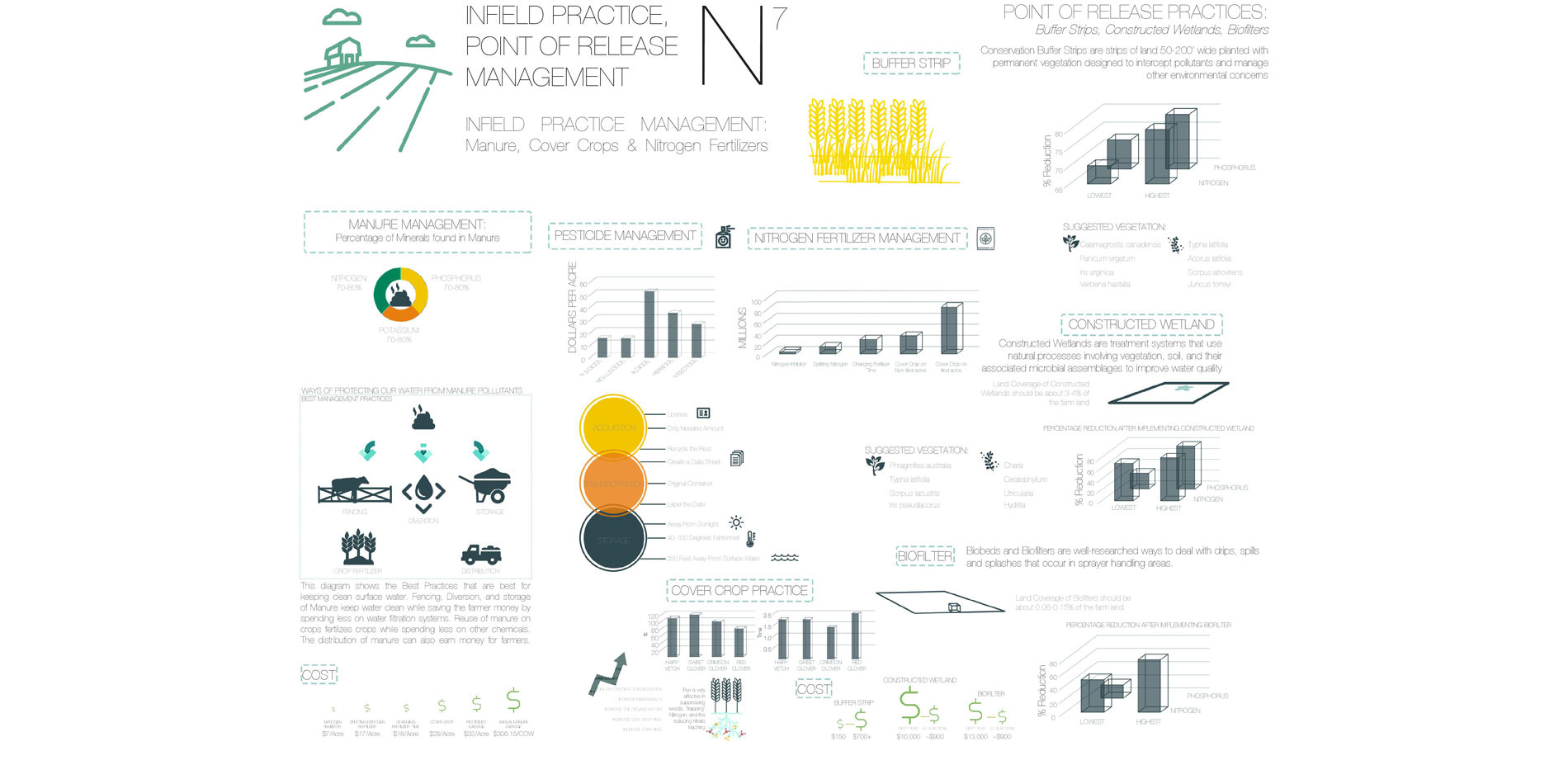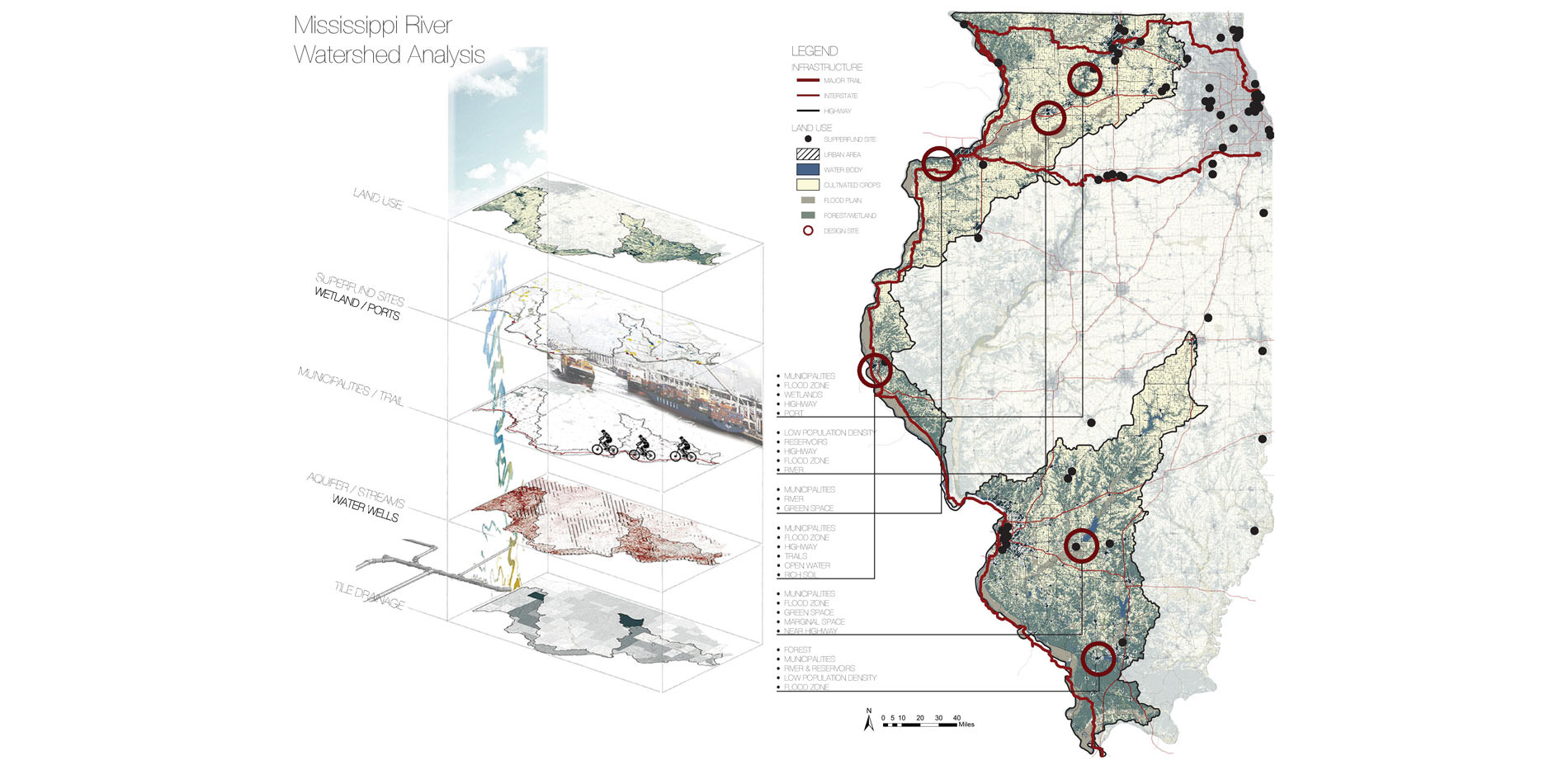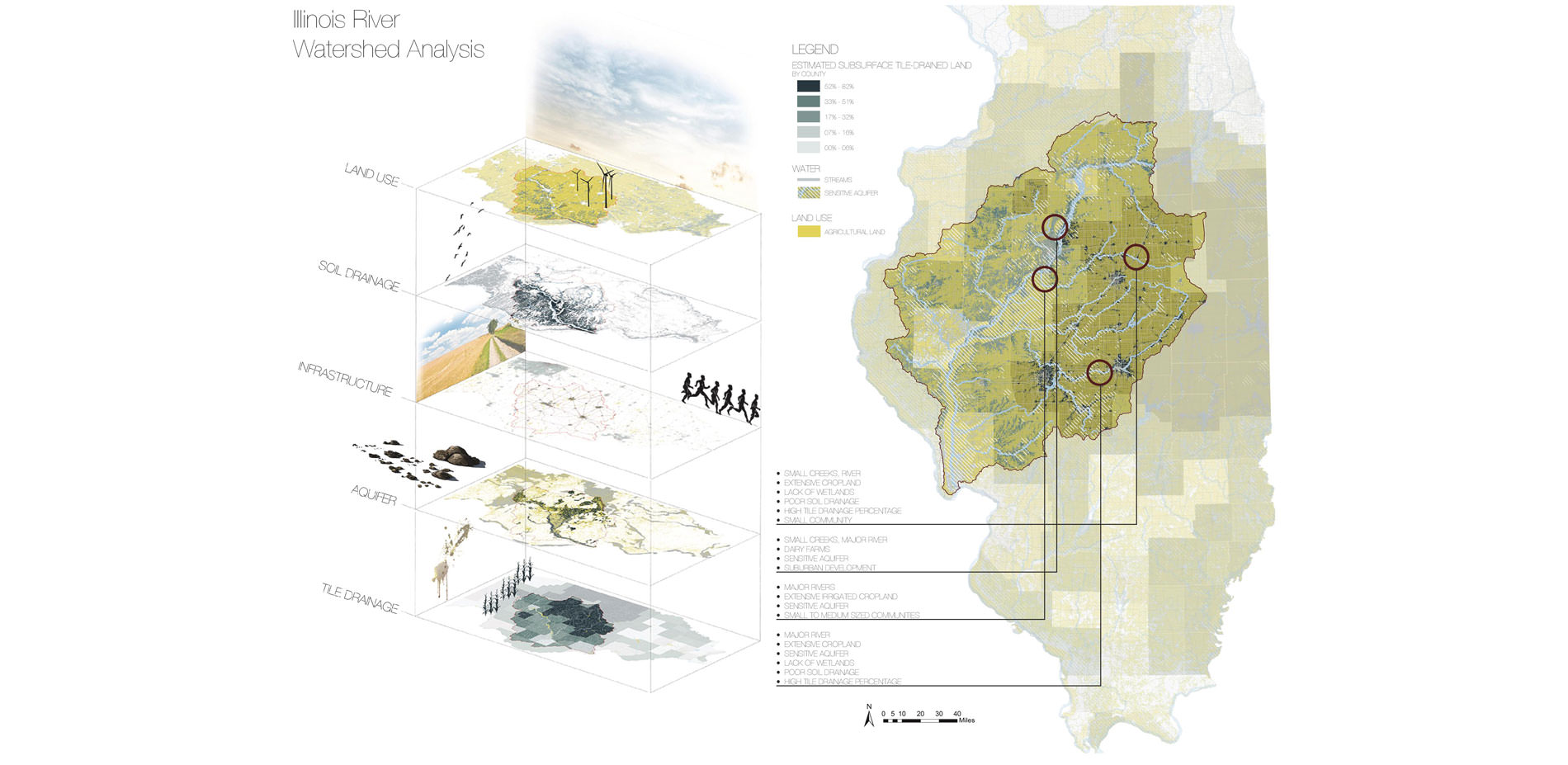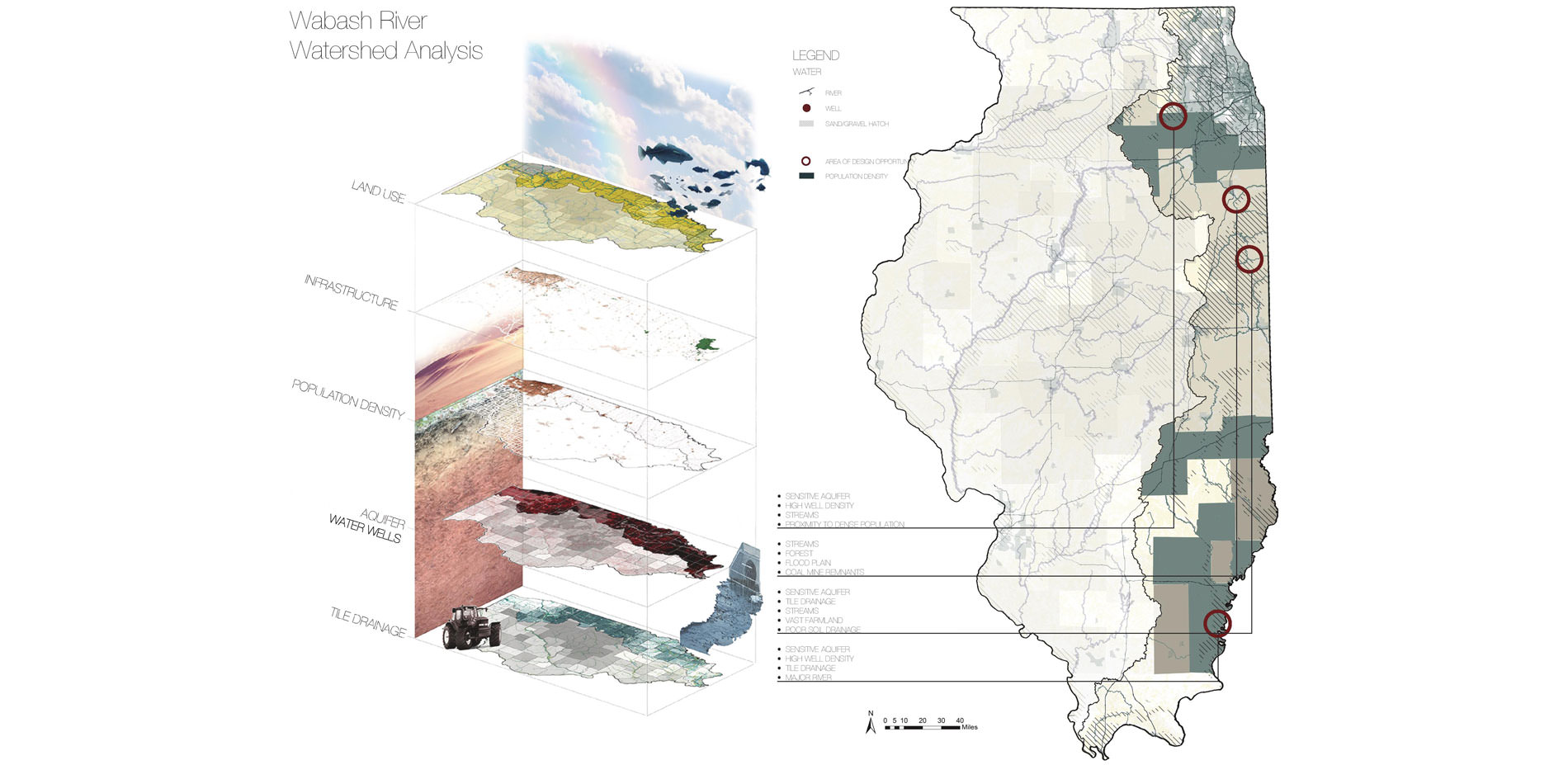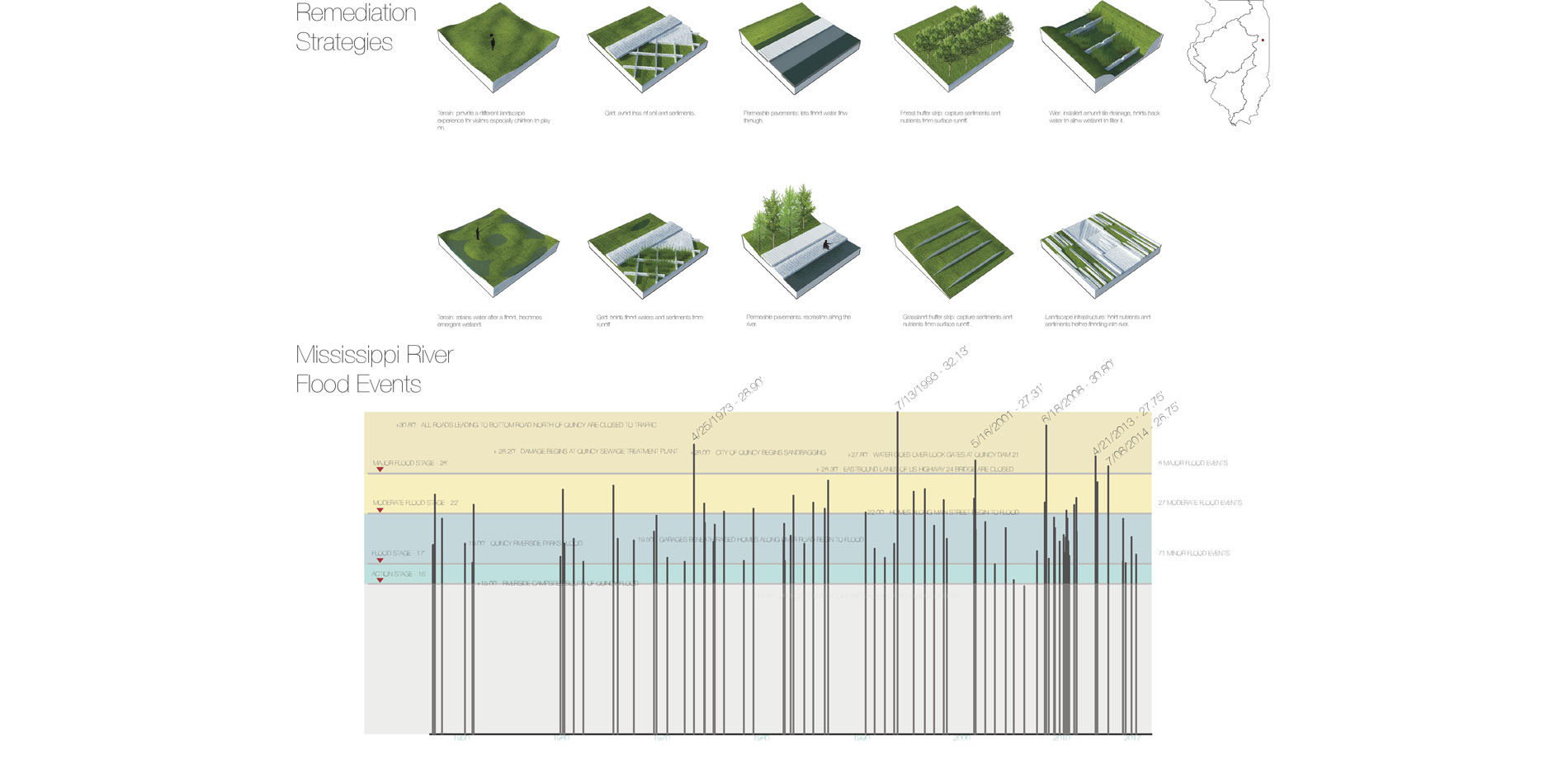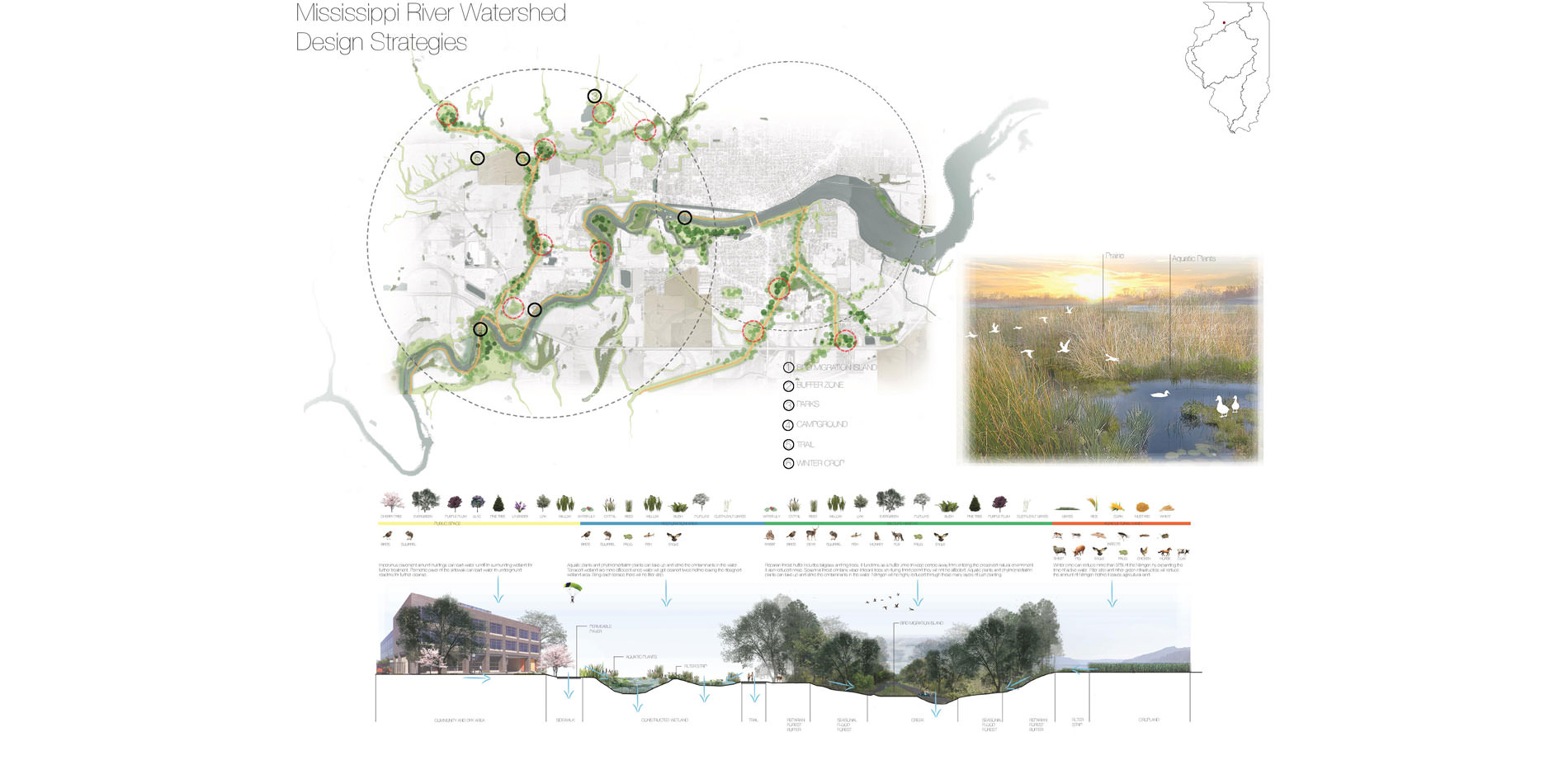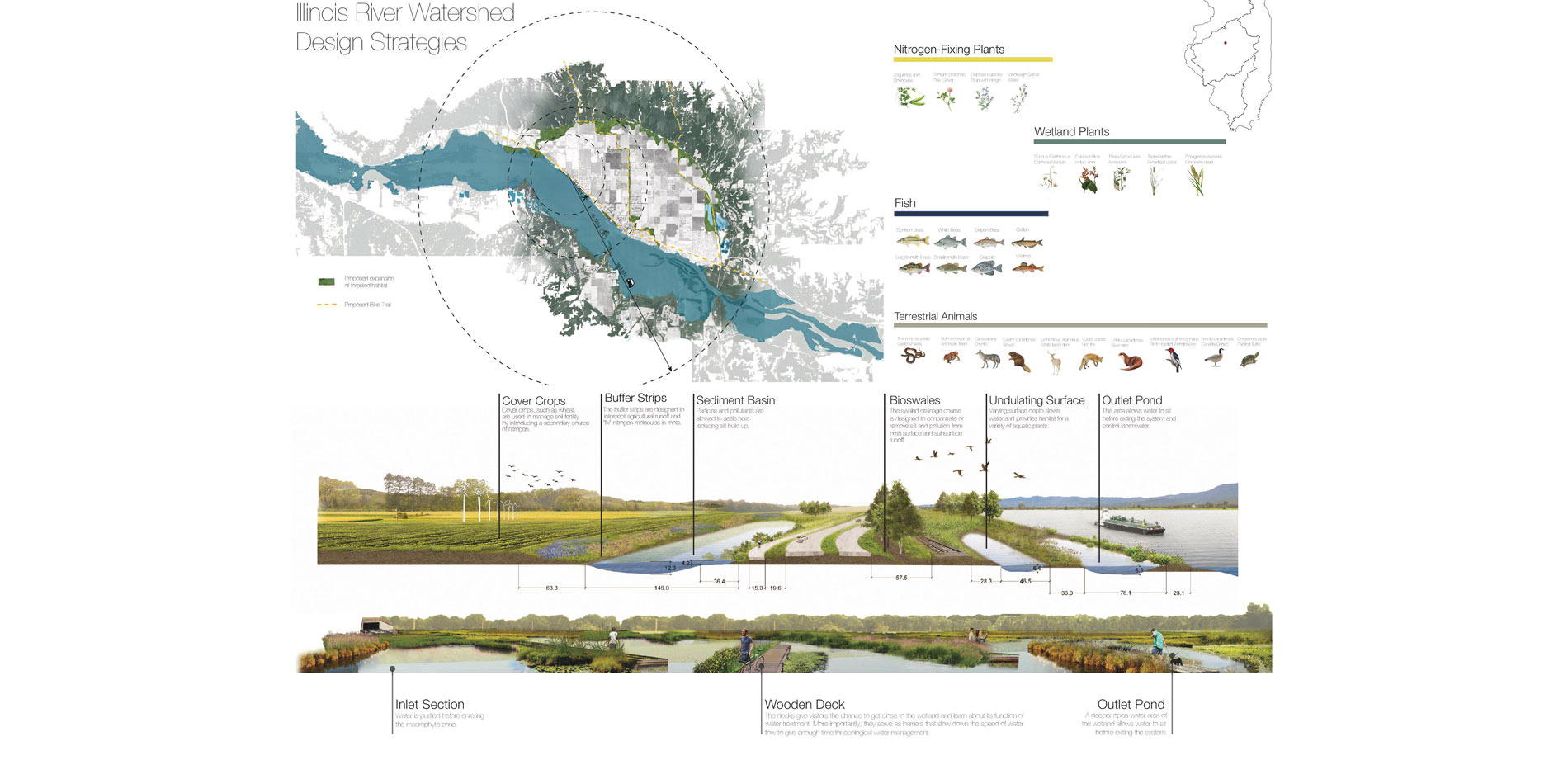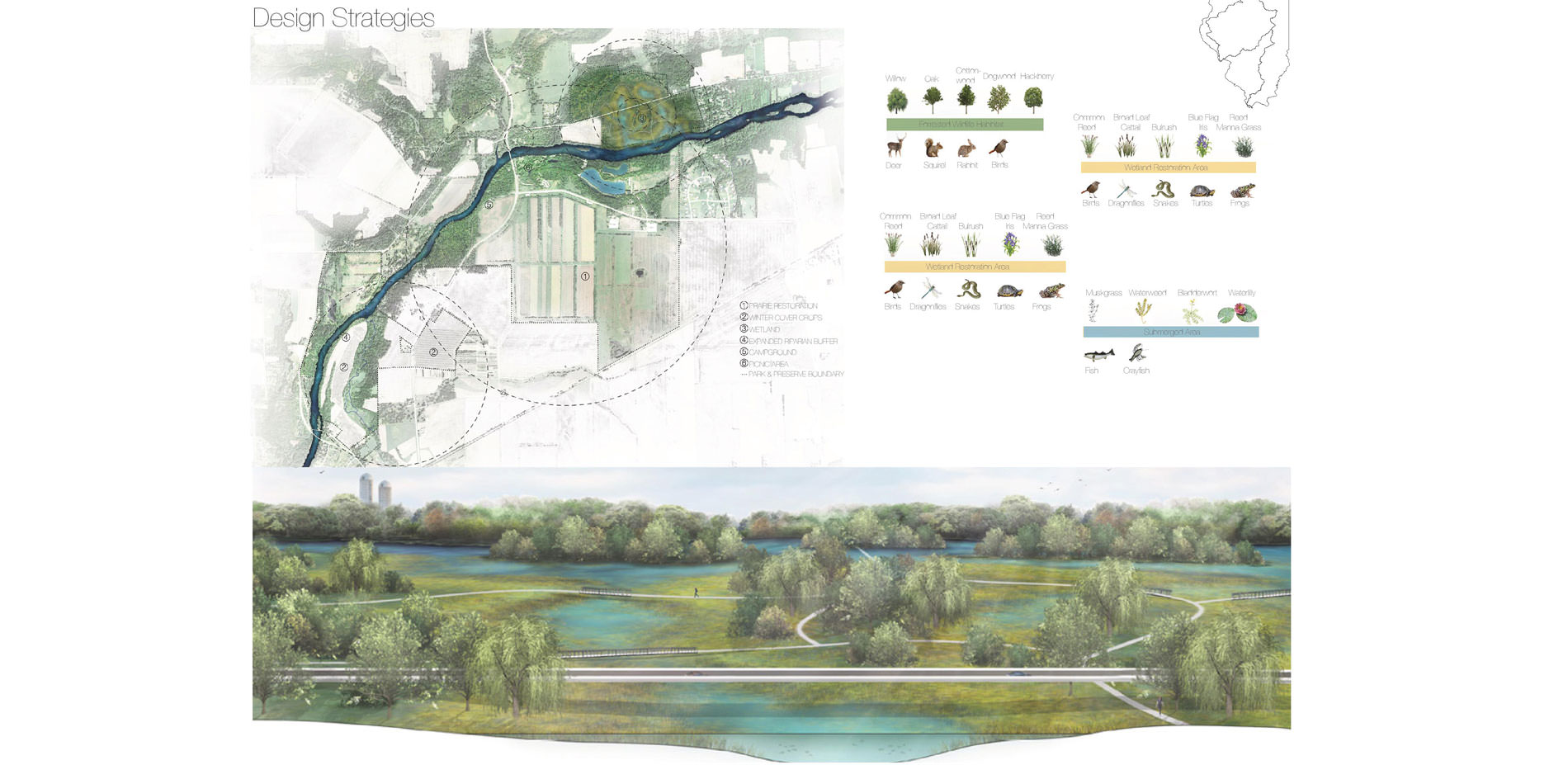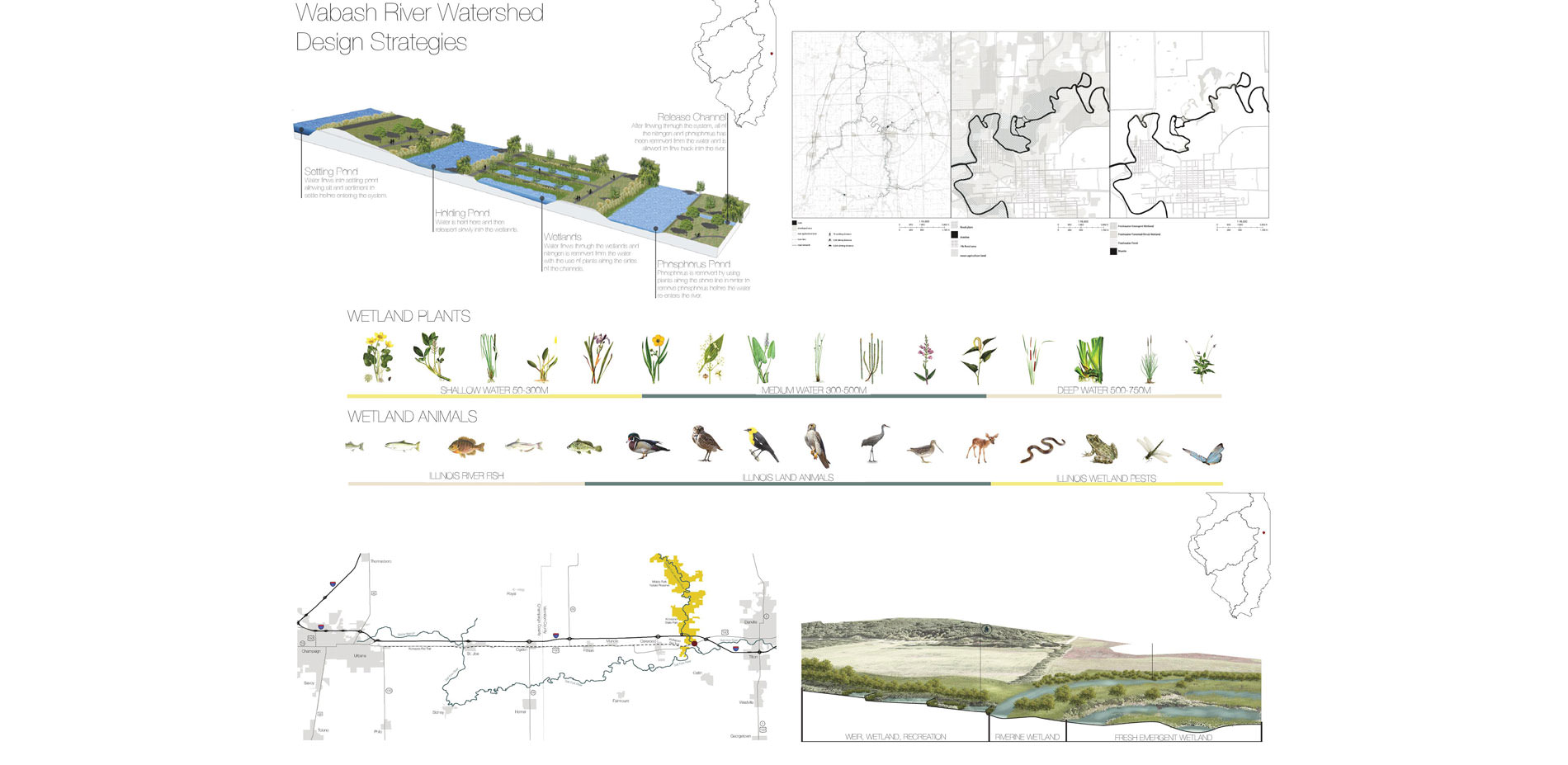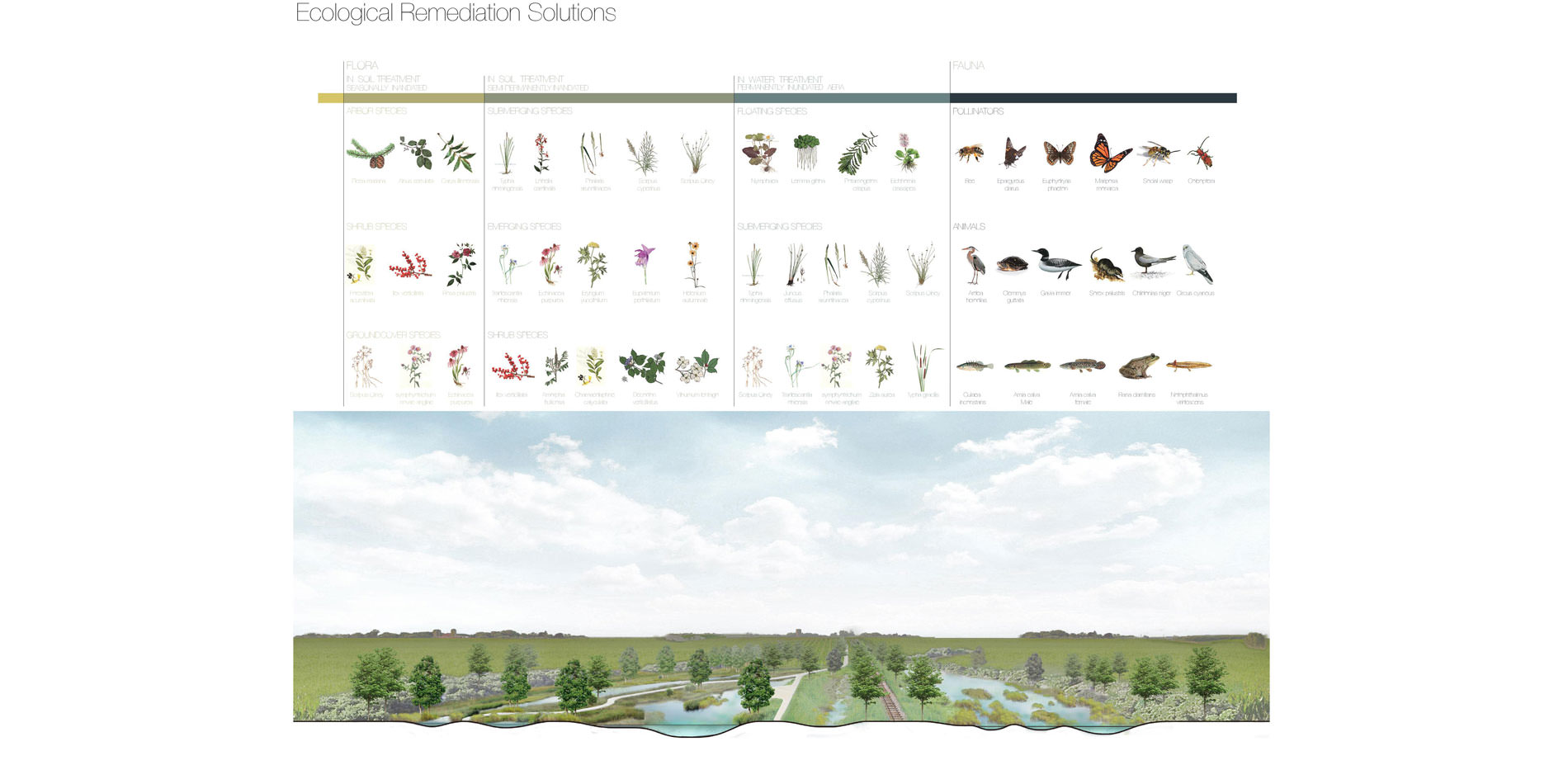Water and the Agricultural Landscape of Illinois
AWARD OF EXCELLENCE
Analysis and Planning
Team: Jacqueline Carmona, Student ASLA; Maria Esker, Student ASLA; Layne Knoche, Student ASLA; Carmeron Letterly, Student ASLA; April Pitts, Student ASLA; Cesar Rojas-Campos, Student ASLA; Zi Hao Song, Student ASLA; Yuxi Wan, Student ASLA; Xiaodong Yang, Student ASLA; Dongqi Zhang, Student ASLA; Nathan Burke, Student ASLA; Yizhen Ding, Student ASLA | Faculty Advisor: Kathrine Kraszewska
University of Illinois at Urbana-Champaign
Thorough in their typologies and recommendations. They’re clear in showing us remediation strategies.
- 2017 Awards Jury
PROJECT CREDITS
- Dongqi Kim
- Zihao Song
- Emma Doyle
- Wanhui Zuo
- Wei Zing
PROJECT STATEMENT
Since the passing of the 1972 Clean Water Act, the United States has been fairly successful at reducing point source contaminant loads in our nation’s water resources. However, despite our relative success, progress needs to be made to ensure water quality. Non-point sources are generally unregulated and continue to adversely affect water quality efforts. Agricultural runoff accounts for the majority of non-point source discharges. Unfortunately, the fertilizers that usually ensure crop health ultimately place distress on aquatic systems. The state of Illinois is one of the leading contributors of fertilizer contaminant loads to the Mississippi River, and in turn the state has a tentative goal of reducing nitrogen and phosphorus loads by 45%. By framing agricultural strategies in the context of landscape architecture, the project aims to provide thoughtful solutions to agricultural issues while keeping the well being of farmers in mind. Instead of completely changing the science behind agricultural practices, the suggested series of interconnected projects offer complementary design strategies such as constructed wetlands to reduce the detrimental effects of nitrogen and phosphorus fertilizers.
PROJECT NARRATIVE
INTRODUCTION: The State of Illinois is home to 74,300 farms, accounting for approximately 27 million acres of arable land, or 75 percent of Illinois’ total land area. The Environmental Protection Agency’s Science Advisory Board set a goal to reduce nitrogen and phosphorus load contributions to the Mississippi-Atchafalaya River Basin by 45%. According to the EPA, Illinois is one of four states in the Corn Belt that contribute to 48% of the nitrogen and 43% of the phosphorus loads that flow into the Gulf of Mexico. Illinois alone contributed about 20% of the nitrate-nitrogen loads, and about 11% of the phosphorus loads into the Gulf of Mexico. The State of Illinois has recommended a series of Best-Management Practices (BMPs) for use by the agricultural community, however, they are a list of suggestions, not policy. The goal of this studio is not to change current agricultural practices, rather, the mission is to develop interconnected, site-specific design strategies that reduce agricultural nitrogen runoff. By examining the BMPs set forth by the Illinois Department of Agriculture, as well as political, social, economic and environmental concerns that stem from these design strategies, resilient design solutions and policies are formed that can be applied on a state, regional and nationwide scale. POLLUTANTS: The Clean Water Act (CWA) divides pollution into point and nonpoint sources. Point sources are controlled by the National Pollution Discharge Elimination System (NPDES). One must have an NPDES permit to discharge from a point source. The CWA defines a point source as “any discernible, confined and discrete conveyance, including but not limited to any pipe, ditch, channel, tunnel, conduit, well, discrete fissure, container, rolling stock, concentrated animal feeding operation, or vessel or other floating craft, from which pollutants are or may be discharged. ”Point Source Pollution does not, however, include agricultural stormwater discharges and return flows from irrigated agriculture. Non-point pollution sources are defined as the distribution of pollutant releases throughout the natural environment, typically extending over large areas. Non-point source pollution was targeted for the purpose of this studio. Nitrogen and phosphorus are both essential nutrients for crops to grow, however, when applied in high concentration, as done in agriculture, many issues emerge ranging from ecological to economic concerns. With the application of nitrogen and phosphorus to farm fields, the nutrients can be quickly transported from application points into subsurface drainage and eventually into larger aquatic systems where the pollutants can cause extensive damage to wildlife and water quality.
TILE DRAINAGE: According to the United States Department of Agriculture, up to 85 percent (9,795,000 acres) of arable land in Illinois is tile drained, the most of any state in the United States. Field drainage efforts in Illinois were set into motion in the late 1800s, and with the 1879 passage of the Farm Drainage Act, drainage systems were quickly developed. However, in the early years of implementation, little was known about the effects such systems could cause on animal and plant habitats and the quality of river and stream water and ecosystems. The method of tile drainage has seen great success in the Illinois agricultural landscape, but it must be noted that this method has come at the price of water and aquatic ecosystem degradation through the channelization of agricultural runoff polluted by nitrogen and phosphorus. ECONOMICS: According to the Illinois Department of Agriculture, more than $19 billion is generated annually from agricultural production in the state, with corn and soybeans alone accounting for 81 percent of the total profit. This revenue is vital to the State of Illinois, and to reiterate, the studio does not wish to change agricultural practices in Illinois, rather to retrofit them using a variety of practices and policy implementations. Many financial incentives and grant programs are already in place to help make this possible. Our studio examined financial programs, grants, and available loans. The Clean Water State Revolving Fund (CWSRF) assists those in creating a wide range of water infrastructure projects. Using a combination of federal and state funds, the CWSRF provides loans to eligible recipients in order to construct municipal wastewater facilities, green infrastructure projects, and pollution control systems. As of 2015, CWSRFs had provided more than $111 billion to communities (EPA). Along with CWSRF, the Drinking Water State Revolving Fund (DWSRF), which was established by the 1996 Amendment to the Safe Drinking Water Act, approves loans. However, the money is to be used specifically for drinking water projects. The Clean Water Act stipulates that individual states are responsible for controlling agricultural nonpoint source pollution (USDA, 1995). To promote the adoption of less polluting practices, a majority of states rely on Education, Technical and Financial Assistance (ET & FA), a component of the U.S. Department of Agriculture’s (USDA) Water Quality Program (USDA, 1995). The goal of this assistance is to disseminate information about profitable and agronomically sound “best management practices” (BMPs) that protect or enhance water quality (USDA, 1995). Aside from profitability, water quality benefits, producer knowledge, and farm size further affect farmers’ interests about less polluting management practices (USDA, 1995). Thus, in order to best engage with farmers and landowners, educational programs should be targeted toward inexpensive, familiar practices with tangible environmental benefits (USDA, 1995).Other than education programs, financial incentives, including cost-sharing and incentive payments, are another critical component to incentivize farmers to adopt best management practices (USDA, 1995); the drawback, however, is the high cost (USDA, 1995). According to some estimates, the cost to encourage the use of improved practices on 176 million acres of cropland that may adversely affect water quality is $3.6 billion (Ribaudo and others, 1993). On the other hand, the deficiency of educational programs is that they have limited success encouraging practices involving large expenditures by the farmer (USDA, 1995). Therefore, to best increase the efficiency of voluntary incentive policies, using both educational and financial incentives may be more successful than implementing each program separately (USDA, 1995).The Conservation Reserve Program (CRP), is a land conservation program administered by the Farm Service Agency (FSA). Enrolled farmers voluntarily remove environmentally sensitive land from agriculture production and plant species that improve the ecological health and quality of the land; in return, farmers receive a yearly rental payment. The goal of the program is to re-establish valuable land cover that can improve water quality, prevent soil erosion, and reduce loss of wildlife habitat. The Environmental Benefits Index (EBI), an evaluative “audit” that assesses an individual’s land, is used to determine the most critical landscapes based on several factors including: wildlife habitat, water quality, erosion, air quality, and cost.
CRP IN-FIELD PRACTICES: There are 36 different practices that can be adopted within the CRP program, including:
- buffers for wildlife habitat
- wetlands buffer
- riparian buffer
- wetland restoration
- filter strips
- grass waterways
- contour grass strips
- shallow water areas for wildlife
CONCLUSION: The agricultural landscape of America is the leading source of nonpoint source pollution. Landowners and farmers are required to meet few legal standards, for there is little policy in place to protect local watersheds from non-point source pollution. For what little policy exists, there is even less infrastructure in place to enforce that those standards are met. This studio has concluded, through various layers of statewide data, several locations that exhibit significant impacts of nonpoint source pollution. Site-specific designs integrated into these locations serve as catalysts for non-point source pollution reduction and help to connect communities across the state to the agricultural landscape of Illinois.

